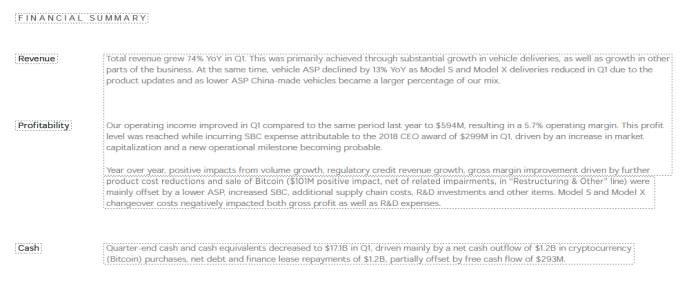[ad_1]
Under the lights of Tesla’s Big Top, you’re never quite sure what sort of show you’re going to get.
But luckily for us, ringmaster Elon Musk brought along the whole circus on Monday night. There was the $594m of operating income that was exclusively down to Tesla selling $101m of bitcoin and $518m of pure-profit regulatory credits. And, of course, there was the mumbly conference call in which Musk attacked the media, waffled about Tesla’s autonomous tech, and delayed several of its key catalysts to 2022.
Those details, however, have been covered elsewhere by the likes of these pink pages, Bloomberg’s Liam Denning and the WSJ’s Charley Grant. In FT Alphaville’s humble opinion, they’re all worth a read.
But there was another oddity less discussed: a weird formatting quirk in the shareholder deck itself.
Turn to page 5, and cast your eyes to the third paragraph down:
Remember here: Tesla’s bitcoin sale represented just over a fifth of its net income, and this is only the time it was mentioned, so this isn’t an immaterial line in the deck.
Anyway, notice anything weird? Yes, that’s correct, the line detailing cost reductions and the $101m of bitcoin sales is not only in a different font, but a slightly different shade of grey.
Even weirder is that the text — unlike the rest of the paragraph — can’t be highlighted. Check it out:
What’s more, none of the words in the sentence can be searched. Try it yourself — hit CTRL+F (or CMND+F, if you’re one of those types) and type “bitcoinâ€. Only two hits, despite being mentioned three times in the document.
Now, we weren’t quite sure what was going on here, so we decided to run the document through Adobe Acrobat Pro DC which allows you to edit the PDF and see the different text and formatting elements. (Not a pitch for the product, we’re sure you use it anyway to be honest.)
Here’s how it looks:
Take a look at the key paragraph — rather than being its own separate text box, it’s split into two parts.
There’s more. Once you start to move the different items around the page, it becomes clear that the offending line is not even text at all. In fact, it’s an image.
Here’s what it looks like when you pull that image out of the paragraph:
So what is going on? Well, it wasn’t a late edit to the PDF to override an existing piece of text, because there’s no other text below the image. So we can just about rule out that explanation.
A more sinister one might be that Tesla’s investor relations department knew journalists, investors and algos would be scanning the text for any mention of bitcoin sales, and wanted to try to hide the fact that these helped to boost the bottom line so much.
We’d love to have asked Tesla for their own explanation so that we wouldn’t be forced to resort to conjecture, but the company disbanded its public relations team in 2020. Oh well.
Instead FT Alphaville asked Nick Mazing, director of research at data provider Sentieo, how common JPEGs in earnings presentations were, and he said:
JPEGs in SEC filings are mostly seen in 8-Ks containing slides from investor presentations or in proxy statements. It is highly unusual to have all images 8-K filings for earnings: this makes searching and redlining against prior versions harder or impossible. The argument one hears from Investor Relations and proxy voting professionals is that JPEGs enhance the communication with ordinary investors. But it certainly brings up the question, is reducing searchability and comparability in the spirit of disclosure requirements, or is it not?
It would be ridiculous to suggest investor obfuscation from most blue-chip companies, but Tesla does have a history of making its documents difficult to read. In the third quarter of 2019 it switched the format of its earnings releases from a document format to a presentation, and with it the text became greyer and therefore trickier to focus on. In the same quarter, it also decided to change to reporting all of its numbers in the millions, rather than the thousands. In effect, three digits got removed from every number that mattered both in the earnings release and the ensuing SEC filing.
This latter tweak was particularly curious as some six-digit numbers had repeated across Tesla’s filings. For instance, in 2017’s third quarter and 2019’s first quarter its work-in-process inventory number was exactly $277,155,000.
Under the same line item in 2019’s second quarter, the figure was $334,641,000. In the following quarter when Tesla decided to report in the millions? $335,000,000.
Whether it’s in its figures, its guesstimates, its attacks on the media, or its production struggles, it seems history repeats more often than not at Tesla.
Tesla’s shares closed Tuesday evening at 704.74, down 4.53 per cent on the day.
Related Links:
A brief history of Tesla and the number 500,000 — FT Alphaville
[ad_2]
Source link










